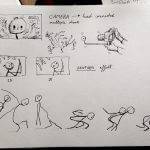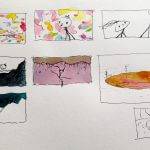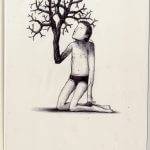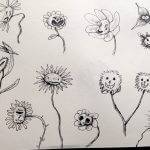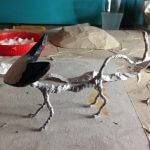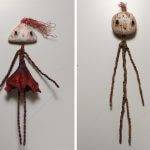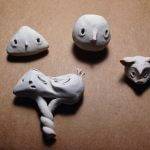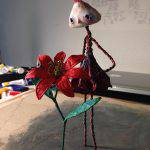Interview: Péter Vácz & Joseph Wallace on the making of JAMES music video “Dear John”
Following his 2014 animated music video All I’m Saying, award-winning director Péter Vácz (Streamschool/Rabbit & Deer) recently created another stop-motion music video for the British band James, this time teaming up with film/theatre director and stop motion/puppetry specialist Joseph Wallace. The song Dear John was chosen by Péter from James’ latest critically acclaimed studio album, Girl at the End of the World, to translate into an animated tale in which a couple’s mountain hike veers off course when a mysterious black cat leads them into a strange forest. The video, produced by Sam Hope of Picasso Pictures, also boasts the talents of Milán Kopasz (set design) and Attila Bertóti (2D animation/FX). Skwigly reached out to Péter and Joseph to learn more about how this tremendously effective and atmospherically rich project came together.
Joseph: I grew up on a diet of Aardman, Ivor Wood, Oliver Postgate and Cosgrove Hall and the shows from those artists and studios nurtured a strong love of stop motion animation. Along the way I’ve worked and trained in various areas from fine art and illustration to acting and performance but puppet animation remains my preferred medium as it is really an alchemic combination of sculpture, painting, photography, design, film and performance.Péter: Unlike Joe, I sniffed the magic powder of animation quite late when I got into university (Moholy-Nagy University of Art and Design). My background for what I’ve become now includes the experience of tinkering in my dad’s workshop as a kid, playing the cello both as a soloist and in a classical orchestra, seeing my father working as a glass designer artist (amongst many other professions), studying graphic design and illustration in secondary school and decorating the streets of Budapest with some ‘personal art’. At MOME Anim I had a few teachers from whom I learned a lot and slowly all my passion started to melt together in the pot of animation film-making.
Péter: The most important knowledge I gained is that I am able to foresee what challenges I will have to face, what materials or help I will need and approximately how long it will take for me to make my idea. To be able to handle all these elements; I learned to plan ahead and make daily, weekly or monthly ‘to do’ lists and schedules in various topics (props, scenes, deadlines, ideas, etc…) to keep my focus on the most important tasks and to develop the whole project in unity. So the KISS principle (Keep It Stupidly Simple) and rational thinking is very useful. Most of my films grow and develop whilst I’m making them so I always have space to improvise and finalise the scene. It’s good to work with other talented people, share knowledge, have trust and give credit to each other because together we can think and make bigger. It’s also better to work in the same place with your team than work separately because you’re less likely to have big misunderstandings or wasted effort. I believe that clear and effective communication and problem solving works best when it’s face to face.
Péter: I was busy making Rabbit and Deer when I received an email from Picasso Pictures saying that they saw my BA graduation film Streamschool and really liked it. They asked if I was interested in having a cup of tea with them in London. When I finished R&D in 2012 December I decided to go to London and visit them as well as see Joseph. That was my first UK visit and not long after I signed to Picasso Pictures.
Joseph: We were both studying for our degrees in animation when we met on the second edition of Animation Sans Frontières, a professional development course for animation filmmakers, and quickly bonded over a shared interest in particular strands of animation and a shared sense of humour. Training together on that course gave us a common ground and we spent a lot of time watching and talking about films together. We’ve worked on each other’s films over the years in different ways, offering an outside eye or dramaturgical support; I’ve also worked with Péter to translate and adapt some of his films into English. In 2013 we co-founded Caravel Collective together in the south of France which was a short-lived but intense period of filmmaking and animation experimentation. During that time we created various films including a micro-short combining live-action and animation which featured Péter as a heartbroken Doctor. We were also commissioned by Animac Festival in Spain to create a live show featuring our films and music which was part lecture, part screening and part gig and subsequently went on to tour to France.
Joseph: Péter had already created one music video for James, for the track All I’m Saying from their previous album, and had made that video on his own in Berlin. For this he wanted to work with other people (animation can be a lonely occupation!) so he brought me in to collaborate. When I joined, Péter had created a range of neon concept art and had sketched the characters of the girl, the boy and the cat (amongst others who were eventually left out). I then took all of that and worked it into a story and structure for the piece which we then developed together over Skype between Hungary and the UK. Later I flew out to Budapest and we got started on all the practical elements. We worked side by side the whole time and both storyboarded and made some models and puppets but for the majority of the time we shared the responsibilities of cinematography, animating and editing.
Péter: I knew I was not going to make Dear John alone so I rented a big room in a nice studio in Budapest to be able to have enough space for more people and more work stations. I asked Milán Kopasz whilst I was developing the idea if he was interested in collaborating in any level and after I sent him the treatment, the designs and the storyboard he said he’d be happy to build the sets. That was a really good news because in his recent graduation film Beyond he crafted wonderful sets and I knew he’d make an amazing job. When I was planning to start the production I got a fever and stayed in bed for almost a week. As I was lying sick I realised that Joseph might interested so I texted him. His positive reply was such a relief and I got really excited that we might work on this together. Joseph and Milán joined me in the studio at around the same time and we started working rapidly. I tried to design and plan everything for them in advance (draw the shape of trees, mountains, choose colours, sketch up the compositions….etc.). Milán built most of the sets based on these designs. Apart from what Joseph mentions above, he was also an amazing help by organising the studio space and the place of the tools each time the project grew so we could be more efficient. Towards the end of the five-week production I saw it would be nearly impossible to finish everything on time so I asked my friend Attila Bertóti (with whom I made ‘Rabbit and Deer’ and his graduation film ’Tale’) to join us and help finishing the 2D flashback inserts. The guys were really thoughtful, precise and intelligent about everything they did. It was all very intense and harmonic in the same time.
Joseph: The aesthetic really came from Péter’s initial drawings. I offered some feedback as to how things could work together or might read better but other than that there wasn’t a particular influence. We pulled together some visual reference at the start which included artists such as Georgia O’Keefe and some fashion make-up that Péter liked for it’s dynamic colour but we didn’t dwell on them for long as we had to dive in and get on with things.
- Image courtesy of Péter Vácz/Joseph Wallace
- Image courtesy of Péter Vácz/Joseph Wallace
- Image courtesy of Péter Vácz/Joseph Wallace
- Image courtesy of Péter Vácz/Joseph Wallace
Joseph – you do a lot of work in theatre and film curation – can you talk a bit about that side of your work and how it relates to/interweaves with your enthusiasm for stop-mo and puppetry?
Joseph: I work as a film and theatre director and specialise in animation and puppetry. So what I make ends up spanning a variety of mediums and techniques and often there are many projects happening at the same time which can be tricky to manage but I love the variation. I have a passion for puppets and stop-motion, you can create vivid and fantastical worlds with puppets on stage and screen because you build the visual language from the ground up. I believe there’s a very tangible relationship between animation and theatre; both are non-literal, both work as metaphor and both deal with a fluidity of space. The films I make tend to be quite theatrical and the performance work I make tends to be quite cinematic so the languages definitely inform each other. Curating and programming, along with writing and lecturing about animation and puppetry, comes from a passion for the medium and a desire to champion animation and puppetry and the cross-over space between those mediums. I’m currently working on a new stop motion short which will continue this vein of exploration and bring theatrical languages I’ve been developing in my live work into the realm of puppet animation.
- Image courtesy of Péter Vácz/Joseph Wallace
- Image courtesy of Péter Vácz/Joseph Wallace
- Image courtesy of Péter Vácz/Joseph Wallace
- Image courtesy of Péter Vácz/Joseph Wallace
Between yourselves and Ainslie Henderson, James have had some fantastic animated music videos of late, what is their attitude toward the value of animation from your perspective?
Péter: James’ first animated video using puppets mixed with live-action backgrounds was made for Frozen Britain by Roger Sargent. I think that fresh and abstract feeling opened the band’s mind to animation. After that, and Ainslie’s delicate video for Moving On, they must have felt that these animations really stood out from the ‘average half slow motion’ live-action music videos. As far as I experienced, the band’s frontman Tim Booth has a strong interest in myths, shamanism and spiritual journeys which is reflected in the songs he writes. He loves the artistic value and the poetry that comes with these beautifully crafted puppet animations and instead of trying to tell me how to do things, he has always encouraged me to follow my instincts. These brought-to-life puppets and their world have their own mystical and spiritual existence that resonates well with James’ songs.
Joseph: We were told that the band’s guitarist thought that All I’m Saying was the best video they’d ever had made for them. The band, and especially Tim, were hugely appreciative of the effort and craft that went into Dear John and offered Péter and I tickets to go to one of their gigs in London where we met them in person for the first time.
Péter: I was living in Berlin when I received an e-mail from Picasso Pictures asking if I was interested in making a music video for a band called James. The final deadline to finish the video was three weeks from that moment and I had a weekend to send in a treatment. From a practical point of view it seemed like an impossible task. I hesitated for a while but then my sister asked if it wasn’t the kind of challenge that I was longing for. I really liked the song so I decided to give it a go. I made a skeleton puppet and some animation tests with aluminium foil and sent it to them. They liked it and I got the job. Then a pure three-week long focused animation improvisation started. I minimised the sets and backgrounds (mostly played with materials) and only worked with two characters. It was an amazing experience; no hesitations, no double thoughts, just planning, working, planning, working… ‘Dear John’ was a completely different experience on a much more ambitious scale where I wanted to try to tell more of a story with more characters and different locations. That obviously brought in a million more questions to be answered and I felt more stressed during this production.
Joseph: I think there are lots of savvy bands who are approaching music videos in a different way to how things have been done traditionally. Artists are looking past the slightly dated mode of focussing on the band in the video, or having cutaways to them performing the song. What we’re seeing more of now are music videos that work on their own terms as films; they work with and compliment the music but they’re also pieces of art in their own right. I think James are very aware of this and want beautiful pieces of art to accompany their songs. So if you have that kind of freedom from a band or a singer who are willing to let artists like us play, then exciting things can happen and it creates a very fertile ground for animators as you can really tell a story or create a visual poetry without having to overtly push a message or product and audiences can feel that.
James can be found at wearejames.com


